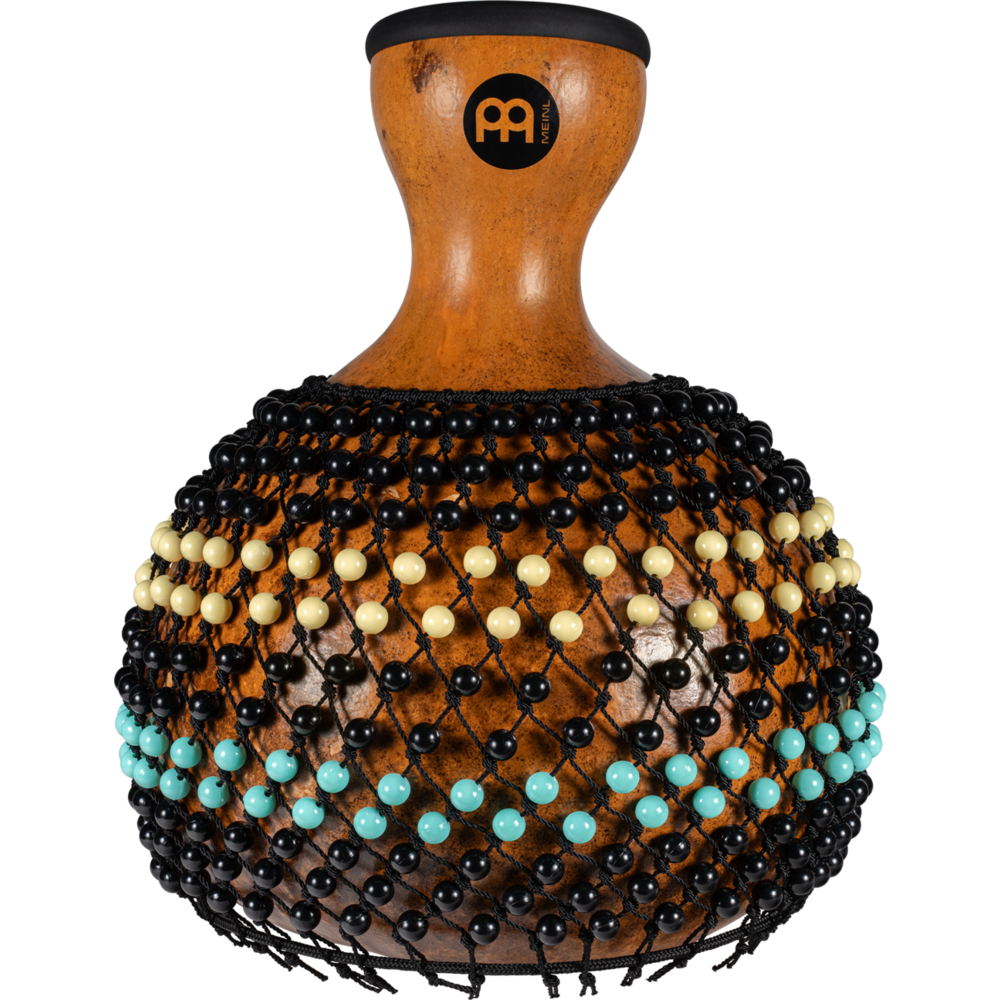Shekere
Percussions
Africa
Between 1001 and 1900 AD
Video
The shekere is a captivating percussion instrument that has deep roots in African culture, particularly originating from the Yoruba people of West Africa. This unique instrument consists of a dried gourd covered with a woven net of beads, shells, or stones, producing a distinctive sound that resonates with the rhythms of life. The shekere has transcended its traditional origins, finding its place in various music genres worldwide, including jazz and popular music.
Description and Features
The shekere is characterized by its hollow gourd body, which is often decorated and covered with a net made from beads or seeds. The sound produced by the shekere is achieved through shaking or slapping the gourd, causing the beads to strike the surface and create rhythmic patterns. This instrument can vary in size, shape, and design, depending on cultural practices and personal preferences.Typically, shekeres are made from natural materials, although modern variations may use synthetic materials for durability and consistency. The beads can be made from various materials, including wood, plastic, or shells, each contributing to the instrument’s distinct sound quality. The adjustable netting allows players to modify the tension for different tonal effects, making it versatile for various musical styles.
History and Origin
The shekere has a rich history that traces back to West Africa, where it is an integral part of many traditional music forms. It is believed that the shekere originated with the Yoruba people of Nigeria, who crafted it from gourds and adorned it with beads for use in ceremonies and celebrations. Over time, as African peoples were displaced through slavery and migration, the shekere found its way to other regions, including Cuba and the Caribbean.In Cuba, the shekere became a staple in Afro-Cuban music and was adapted to fit local musical styles. The instrument has been embraced by various artists and musicians across different genres, showcasing its adaptability and enduring appeal. Today, the shekere is celebrated not only for its musical contributions but also as a symbol of cultural heritage.
Working Mechanism
The shekere’s working mechanism is relatively simple yet effective. When played, the musician holds the gourd in one hand while using the other hand to shake or slap it. The beads or shells attached to the net strike the gourd’s surface, creating a rhythmic sound that can vary from soft to sharp depending on how forcefully it is played.Musicians often use different techniques to produce various sounds; for instance, they may shake it gently for a softer tone or slap it firmly for a more pronounced effect. The ability to control the tension of the netting further enhances sound production, allowing for both quick responses and slower, more resonant sounds.
Types of Shekere
There are several types of shekeres available today:
Traditional Shekere: This type typically features a rounded head with a handle and produces crisp tones that are higher than other forms.
In Touch Shekere: Characterized by an oval head and larger curved handles, these are lighter than traditional models.
Tube Shekere: These have a cylindrical shape that facilitates rapid movements and quick rhythms.
Each type serves different musical contexts and preferences among players.
Music Composed with Shekere
The shekere plays a vital role in various musical genres. In traditional West African music, it accompanies dances and ceremonies, providing rhythm and enhancing communal celebrations. In Afro-Cuban music, it contributes to complex rhythmic patterns found in genres like son cubano and rumba.Beyond traditional settings, contemporary musicians have integrated the shekere into jazz ensembles and popular music compositions. Its unique sound adds depth and texture to modern arrangements, making it a sought-after instrument in diverse musical landscapes.
Significance of Shekere
The significance of the shekere extends beyond its musical capabilities; it embodies cultural identity and heritage. In many African communities, playing the shekere is not just about creating music; it’s about storytelling and preserving traditions through rhythm. The instrument fosters unity during celebrations and rituals, bringing people together in shared experiences.In educational contexts, learning to play the shekere can promote cultural appreciation among students while enhancing their understanding of rhythm and percussion techniques.
FAQ
What are the characteristics of a Shekere musical instrument?
The Shekere is a traditional African percussion instrument made from a gourd that is covered with a woven net of beads or shells. It is played by shaking or striking the beads against the gourd, producing rhythmic sounds. The instrument can vary in size and is often used in African, Latin American, and Caribbean music. It creates a deep, resonant sound that adds texture to musical performances.
What is the origin of the Shekere?
The Shekere originated in West Africa, where it has been used for centuries in various cultural and ceremonial contexts. It is particularly associated with the Yoruba people but is found throughout many African cultures. The Shekere was brought to the Americas through the transatlantic slave trade, where it became integrated into Afro-Caribbean and Afro-Latin music traditions.
What are the types of Shekere available?
There are various types of Shekere, categorized by size, material, and the kind of beads or shells used. The larger Shekeres are used in traditional African ceremonies, while smaller versions are used in popular music and performances. Some Shekeres feature shells or metal beads, while others use natural fibers or wooden beads. They can also vary in terms of the tone, with some offering deeper bass sounds and others producing sharper, higher-pitched tones.
 Links
Links
References
Other Instrument
Categories


















